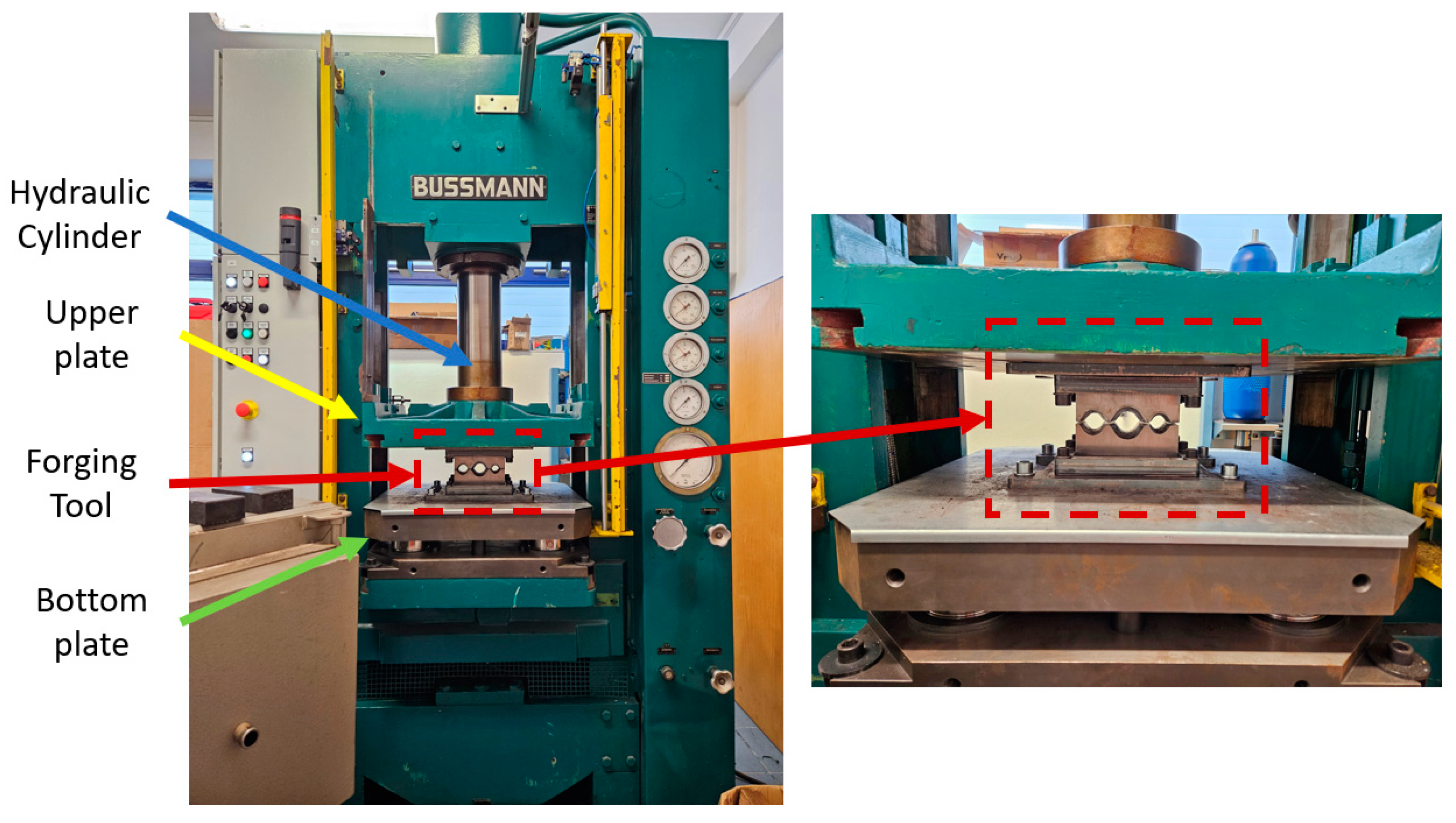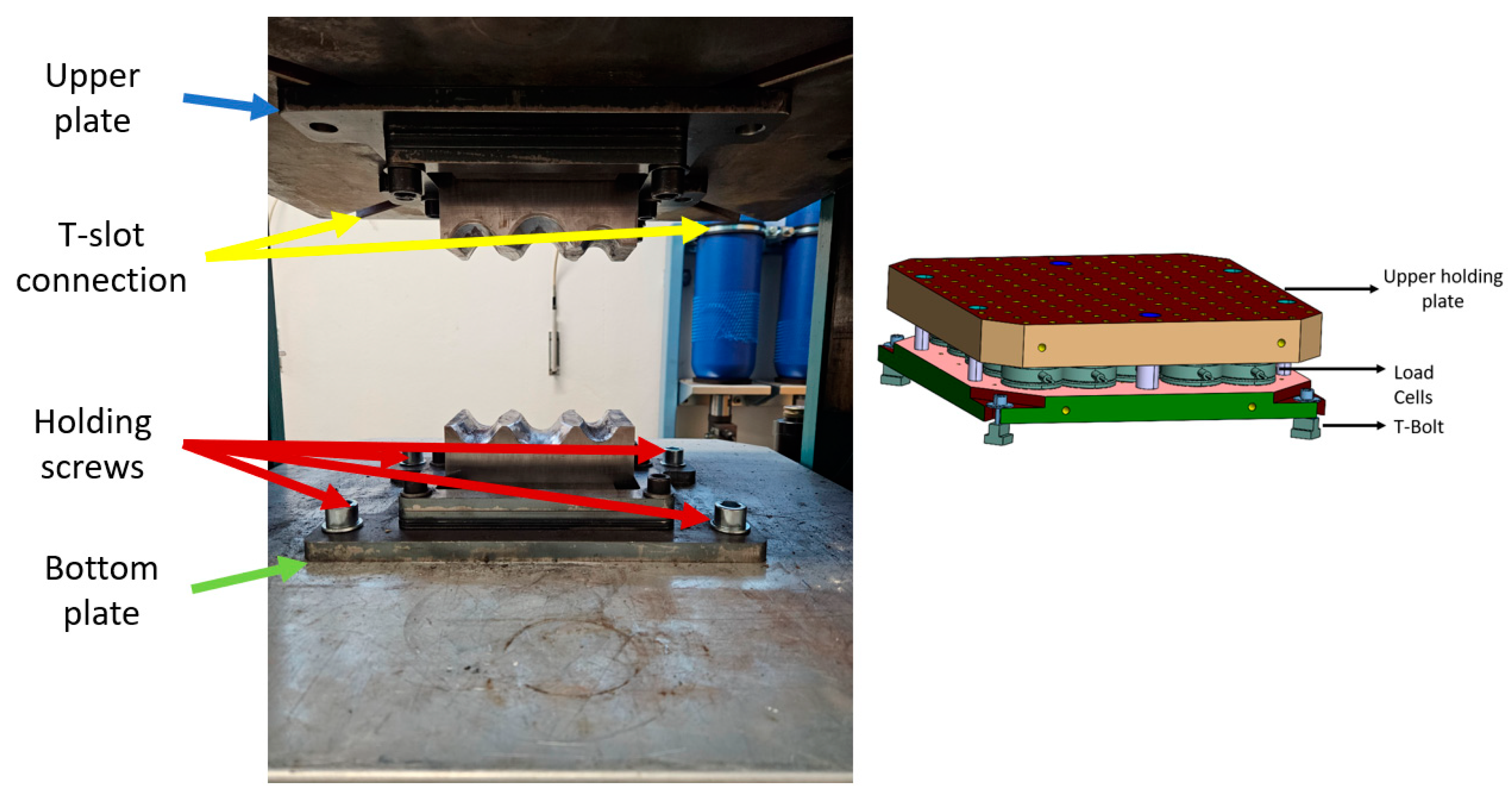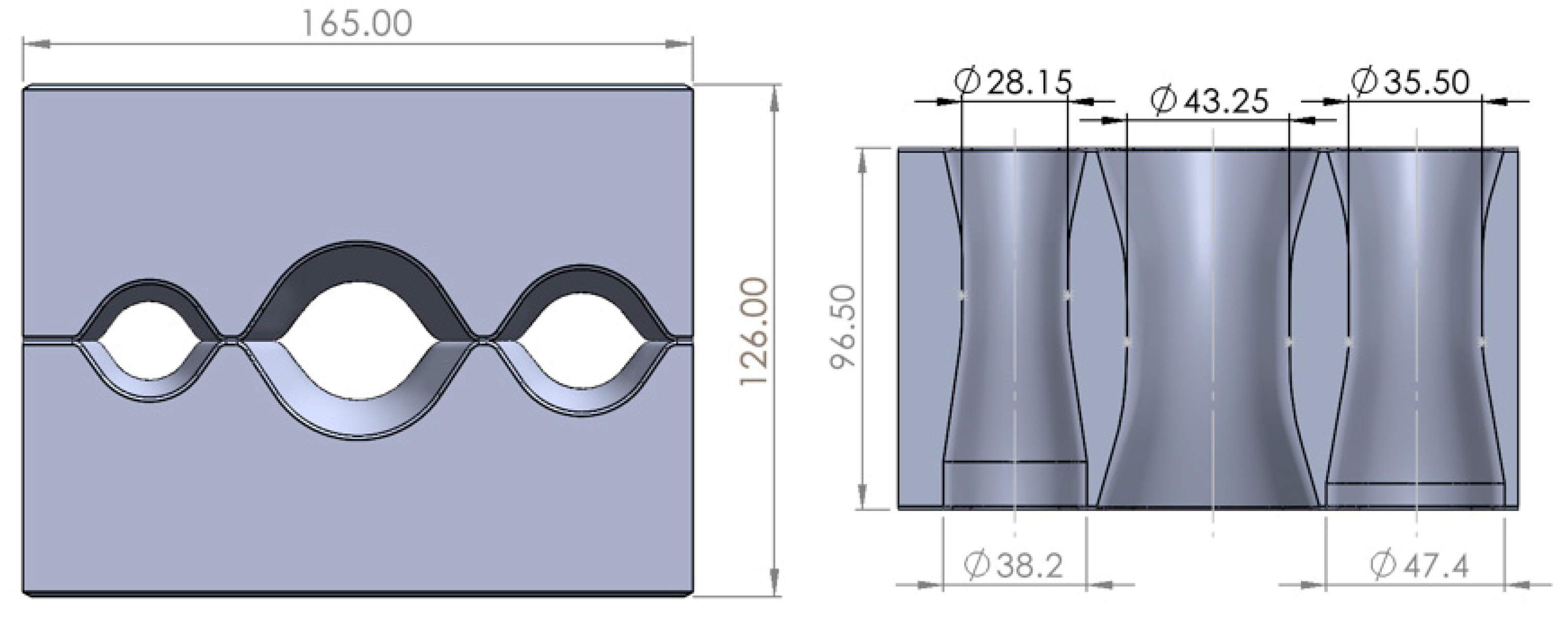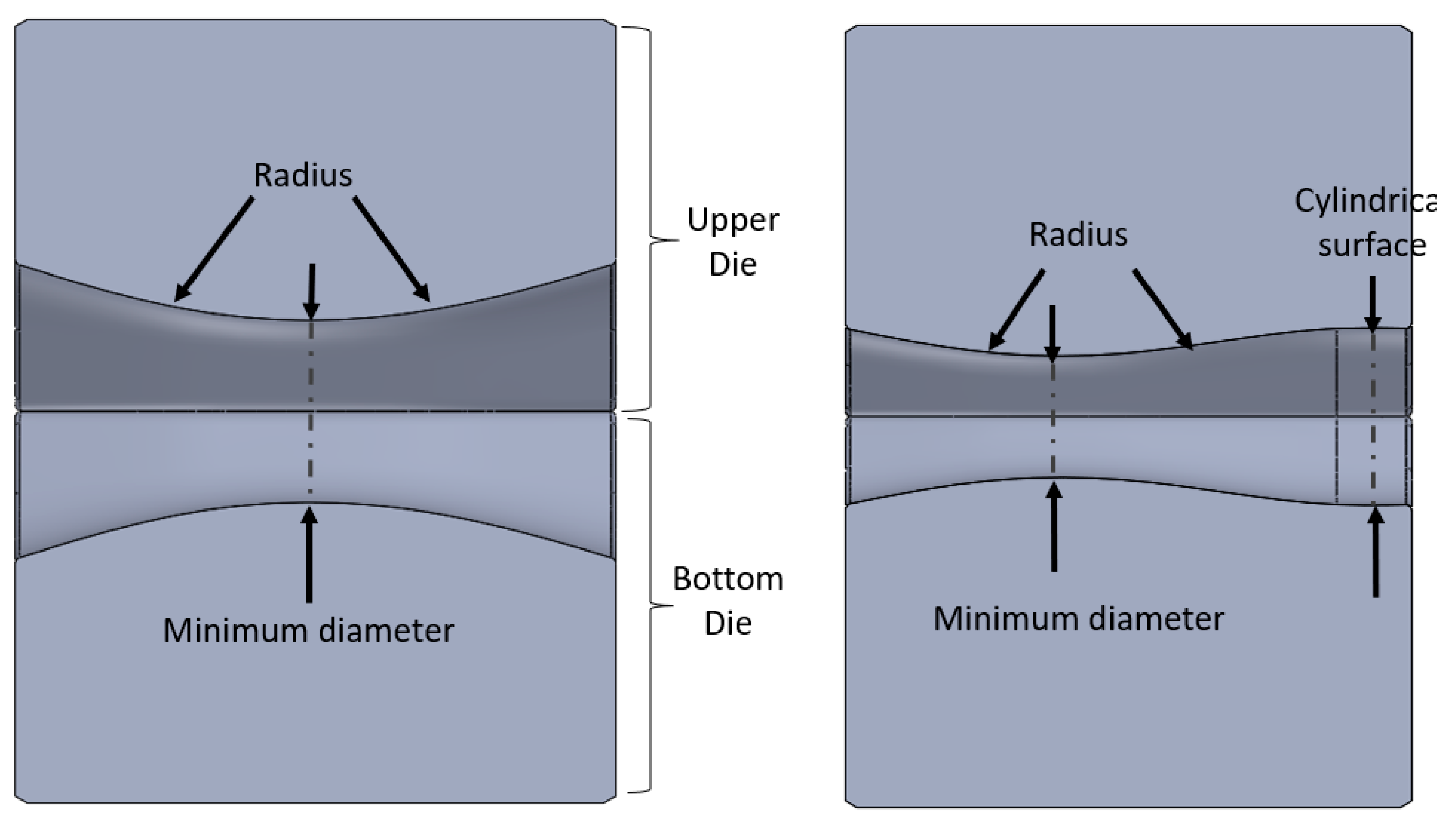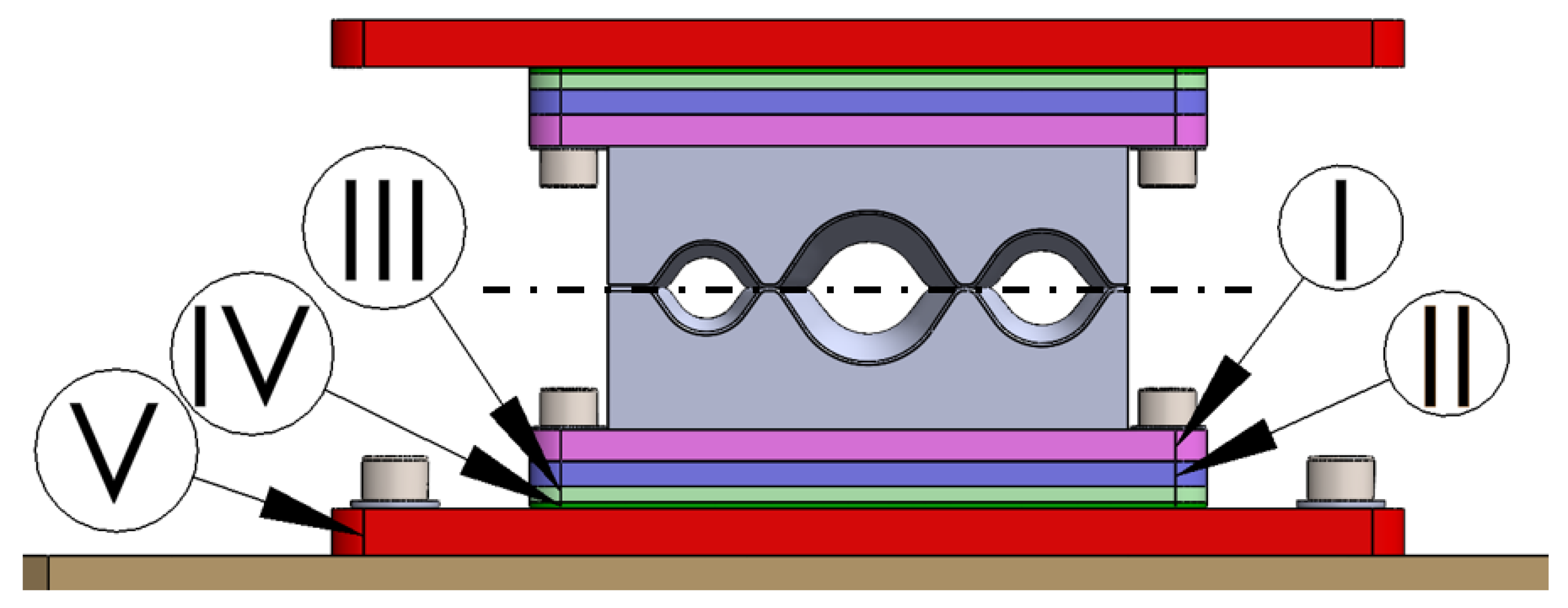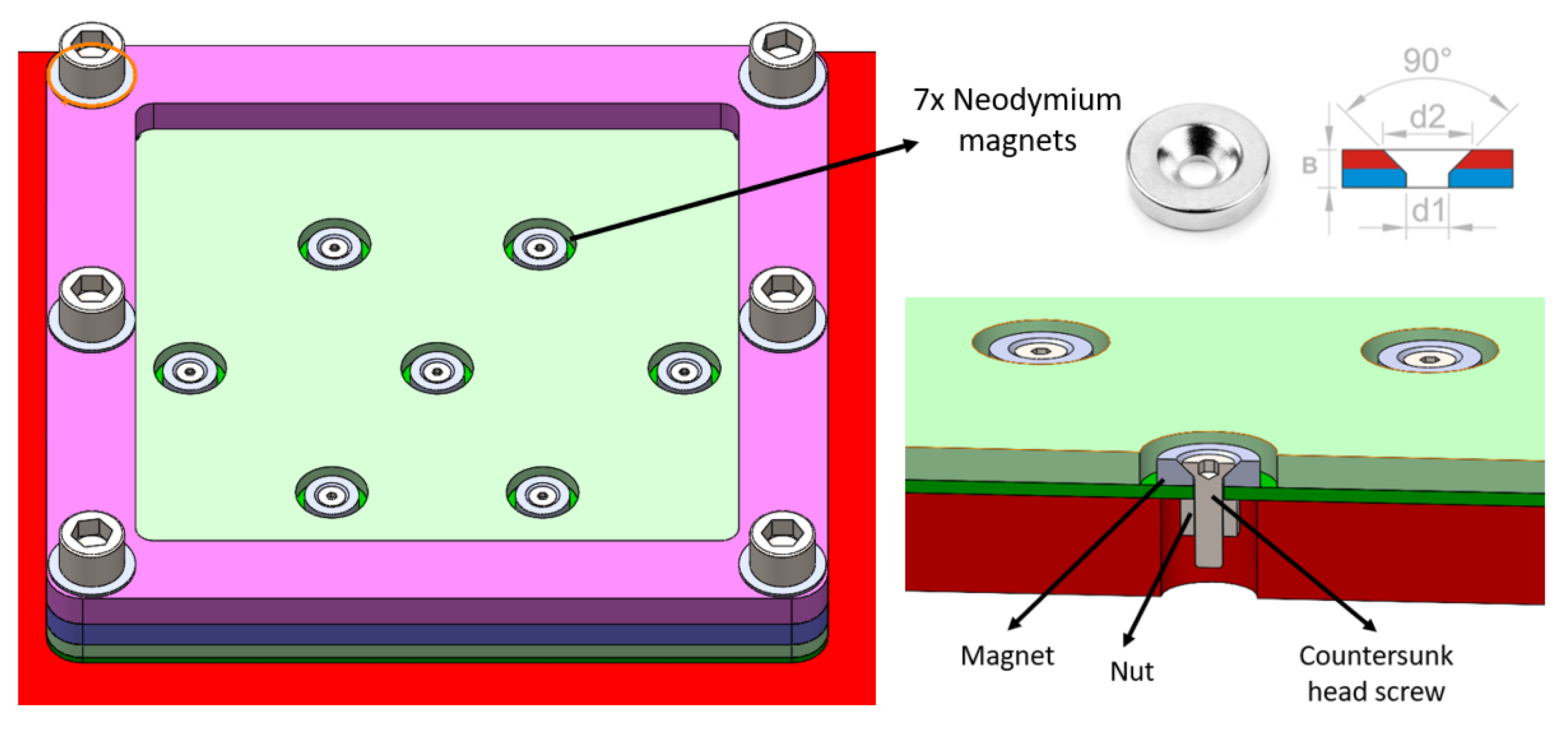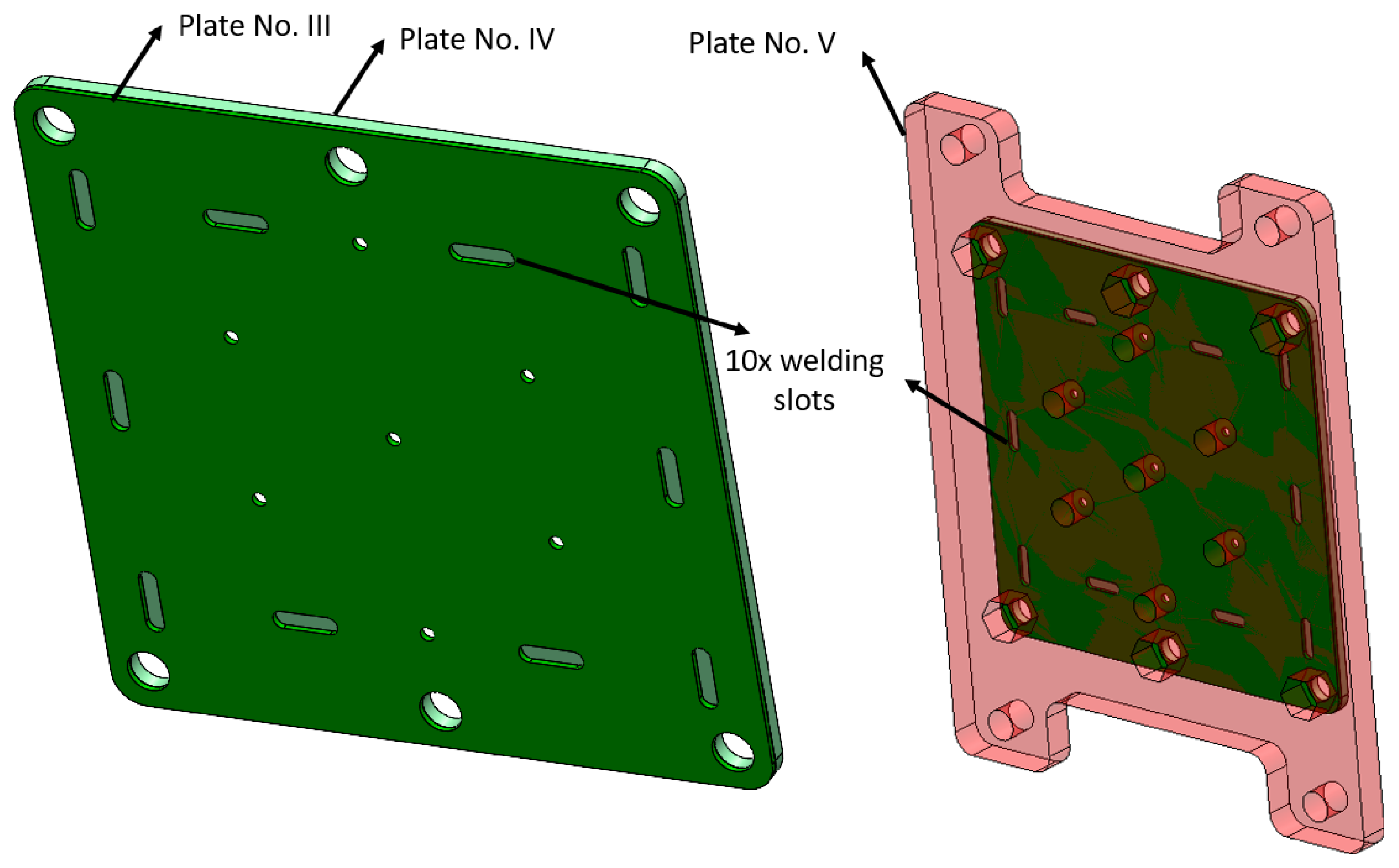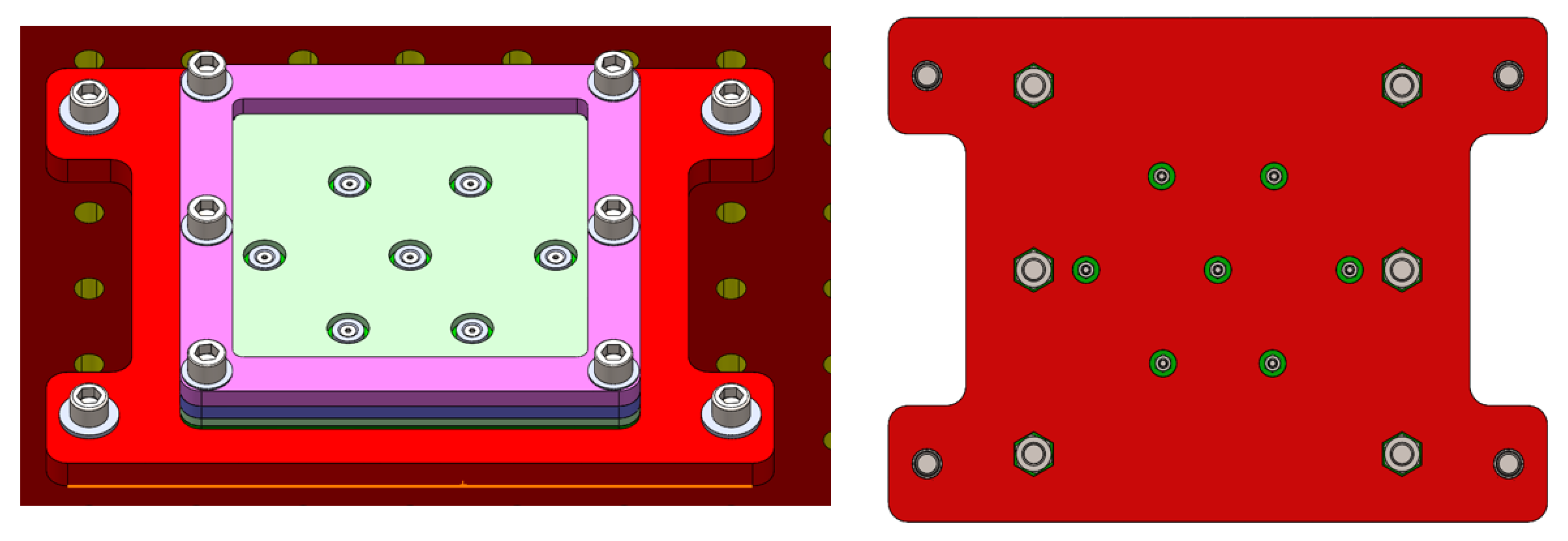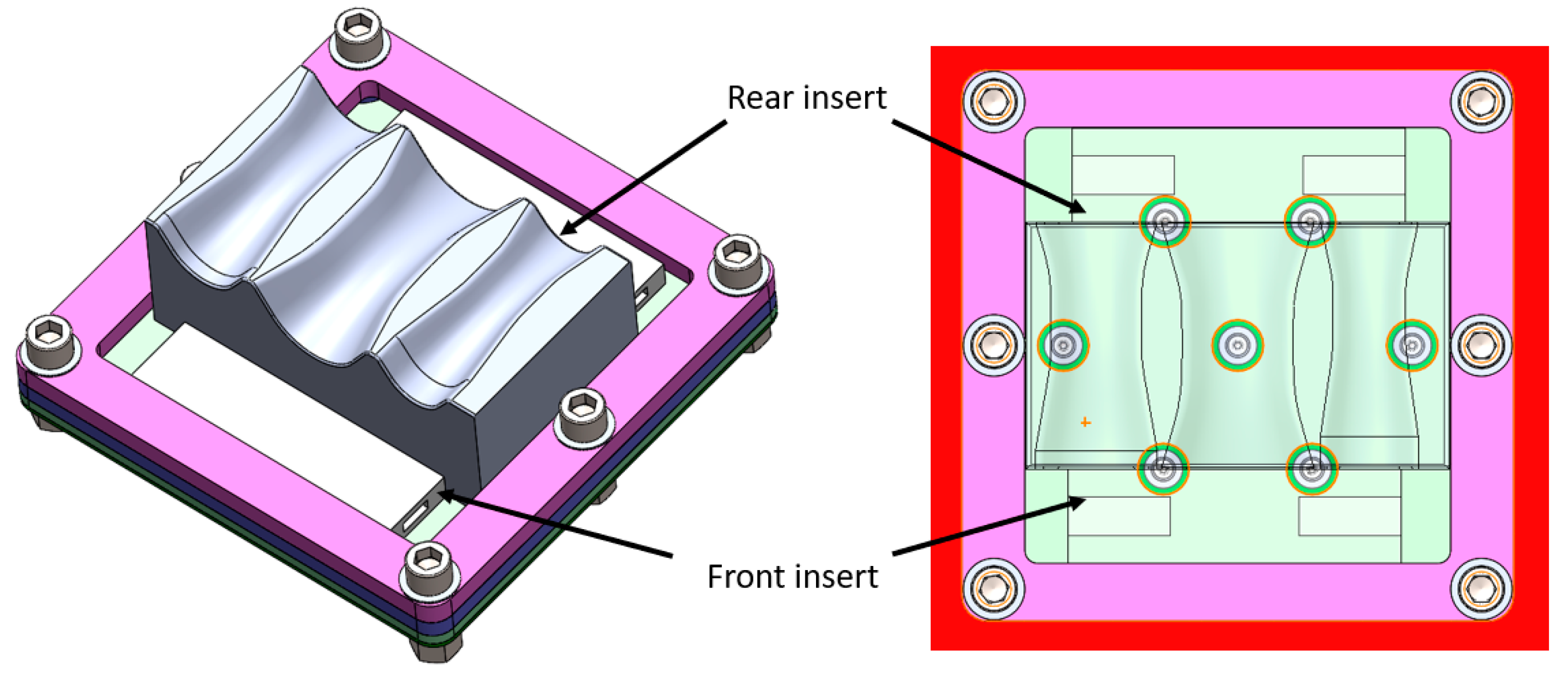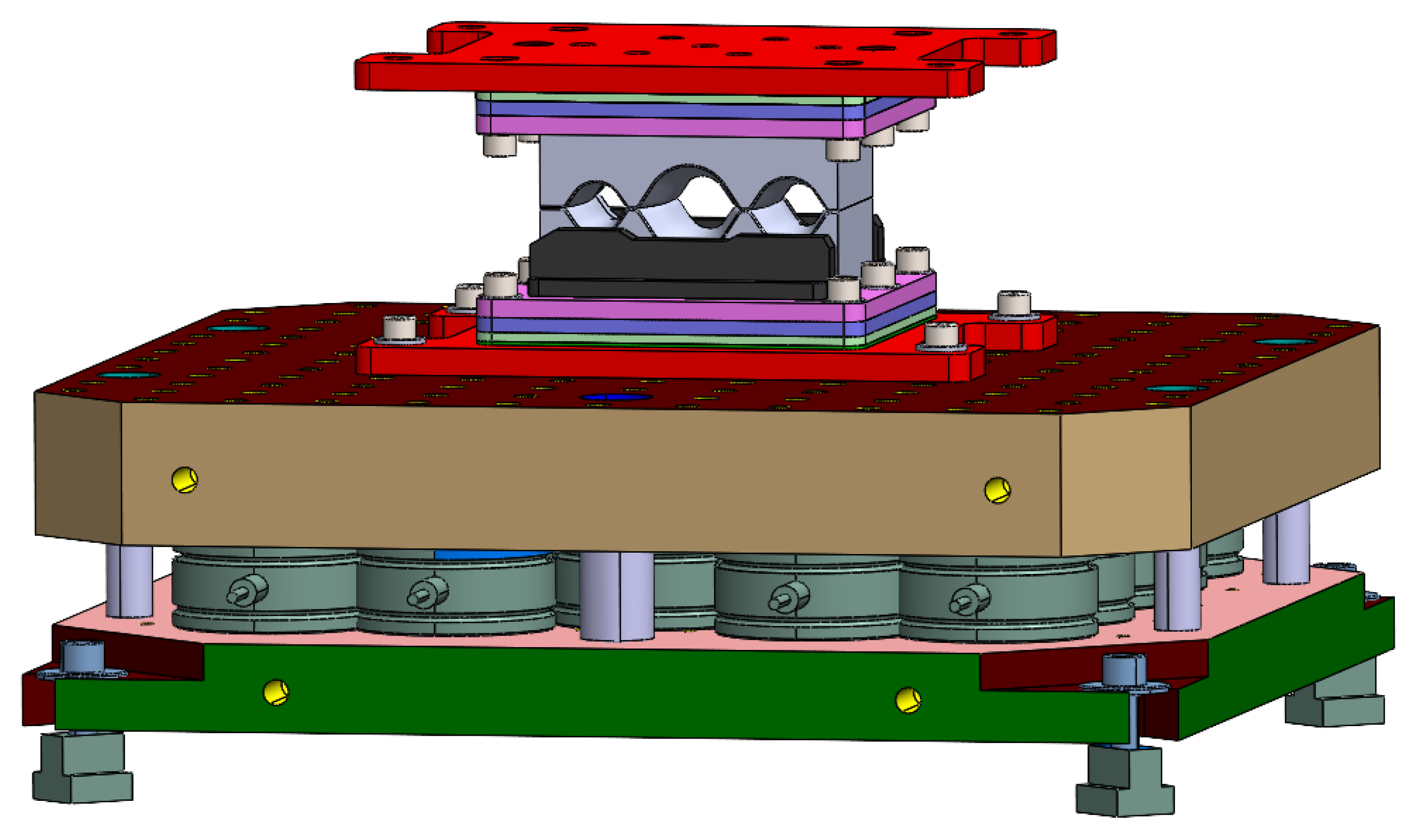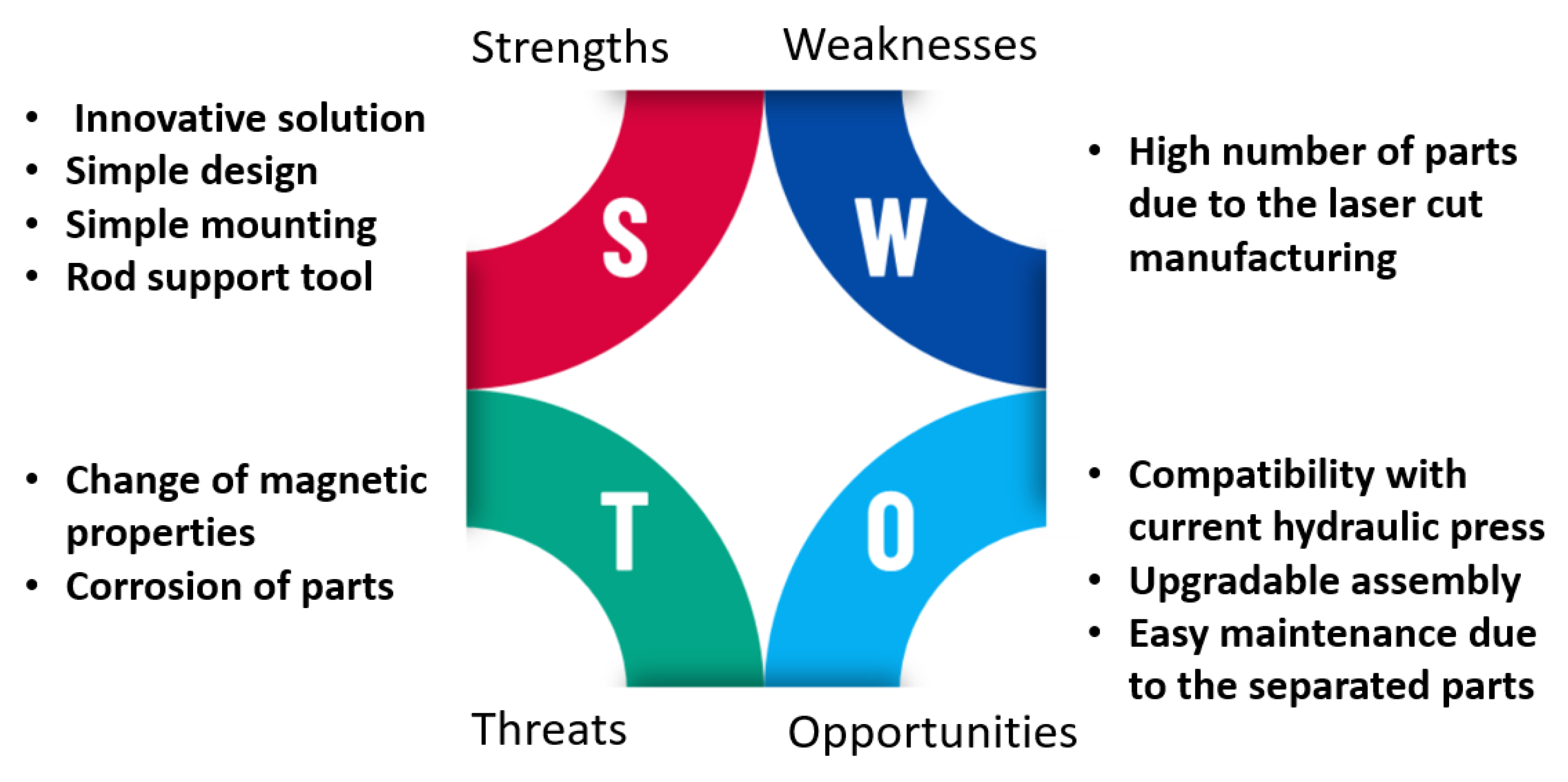1. Introduction
Forging is one of the oldest and most well-known metal manufacturing processes and forming technologies. Despite the widespread adoption and updating of many new and advanced forming technologies, metal forming remains in high demand in several engineering industries. Forged products have good mechanical properties with small material waste [
1]. Radial forging is a bulk metal forming process for manufacturing axles and shafts and reducing the diameter of rods and tubes [
2]. Compressive forces are applied to the initial material. These forces are applied through hammering, pressing, or rolling. Designing suitably shaped forging equipment and tools leads to the creation of plastic deformations in the formed material, which achieve the desired shape of the product without compromising the material’s cohesion. Therefore, the design of dies for forged products has a great impact on the quality, cost, and delivery of forged products. However, the engineering design of the forging equipment requires extensive knowledge of and experience in forging technology to effectively meet a material’s shape requirements.
Forging methods are distinguished mainly by the design and shape of the dies, the shape of the material, and the forging conditions. Generally, the forging process is classified according to the working temperature. If it is performed at room temperature, then it is called cold forging; if it is performed above room temperature but below the recrystallization temperature, then it is known as warm forging; and if it is performed at above the recrystallization temperature, then it is known as hot forging [
3,
4]. Based on the die shape, forging can be divided into open-die forging and closed-die forging. This means that the forging equipment is one of the main keys to accomplishing successful material forming.
Digital twinning has emerged as a breakthrough technology in the field of engineering and manufacturing, offering significant advantages, such as reduced development costs, optimized performance, and enhanced maintenance capabilities [
5,
6,
7,
8]. By creating a virtual replica of physical equipment, digital twin technology enables engineers and operators to monitor and simulate the equipment’s behavior in real time, identify potential issues before they occur, and evaluate design changes in a risk-free environment. The magnetic forging holder is a critical component in a hydraulic press for the production of high-quality products and materials. A digital twin of this component provides us with the opportunity to connect the device to cyber-physical systems. This holder is considered as a virtual object, allowing for the continuous monitoring, simulation, prediction, and optimization of its performance. This technology can also help engineers and operators identify potential failures and problems in the equipment, optimize maintenance schedules to prevent downtime, and evaluate different design changes without risking the actual equipment. Furthermore, as the digital twin for the holder can be linked using cyber-physical integration and advanced sensors, it could provide an excellent opportunity to capture and analyze data in real time, which can be used to enhance situational awareness, operational flexibility, and energy consumption [
9,
10,
11,
12,
13]. Additionally, the application of augmented reality and virtual reality with the digital twin can provide operators with a more immersive and interactive experience when interacting with the holder virtually. The creation of a digital twin for this equipment can improve the monitoring of the condition of the device and enhance maintenance processes, leading to improved performance, reduced costs, and increased operational efficiency [
14,
15,
16].
In recent years, there has been increased interest in using digital twinning to enhance the monitoring of the condition of industrial equipment. Condition monitoring is a crucial task in monitoring the lifecycle of complex equipment, as it is used to monitor the equipment’s condition and design accurate models for assessing its health and improving its performance. This research presents the design and development of digital and physical twins of a magnetic forging holder used in the compacting and hot forging of a newly developed composite material based on Fe—Al—Y with high creep resistance. The physical twin of the tool consists of a separate forging element called the die and a fastening part that holds the die in position. The tool is complex for digital twinning but more user-friendly for use in industry. The fastening part of the tool was produced using rapid tooling technology, which utilizes a folded sandwich construction of laser-cut parts from common sheet metal. This provides the ability to replace individual parts by bolting the entire structure and attaching it to the press. The die is fixed and quickly replaced using neodymium ring magnets. The forging tool is also equipped with leveling supports that allow for correcting any irregularities in the direction of the longitudinal axis. The entire tool was manufactured using a technology that does not require manual locksmith work except for assembly. Currently, the tool is being used in research, and requirements are being collected for the possible further simplification of and improvement in its design and operating characteristics.
The main contribution of this paper is the development of a digital twin of special open-die hot-forging equipment that is held by magnetic forces, with the aim of enabling its integration into a smart manufacturing environment. The design process for the digital twin was carried out using SOLIDWORKS software, which enabled us to optimize the design of the equipment holder to ensure compatibility with the Bussmann Hydraulic Press HPK100. This compatibility is crucial for the successful operation of the equipment within the smart manufacturing environment.
4. Discussion
Digital twins are virtual replicas of physical objects or processes that provide real-time monitoring, analysis, and optimization capabilities [
19,
20,
21,
22]. With the ongoing development of cyber systems and intelligent technologies, such as Industry 4.0, the Internet of Things (IoT), cloud computing, and next-generation AI, digital twins have become an essential component of the manufacturing industry [
23,
24]. Furthermore, under the Industry 4.0 paradigm, scheduling should deal with smart and distributed manufacturing systems supporting novel and emerging technologies, such as digital twins, cyber-physical systems, and big data. Digital twins are of paramount importance for the effective functioning of smart manufacturing and cyber-physical systems in the Metaverse. These virtual replicas of physical objects, processes, and systems enable real-time monitoring, simulation, analysis, and optimization capabilities. In addition, digital twins are crucial for predictive maintenance in manufacturing systems, as they can provide insights into the equipment performance and health conditions. Moreover, by connecting digital twins to the Metaverse, it is possible for companies to design and test new processes using virtual simulations before implementing them in a physical environment. This can significantly reduce the costs and risks associated with changes to the manufacturing process. Therefore, the use of digital twins and cyber-physical systems is a necessary step towards the realization of smart manufacturing in the Metaverse. Moreover, the integration of digital twins and cyber-physical systems has ushered in a new era of sustainable smart manufacturing.
The rapid progress in information and communication technology (ICT) has captured the interest of numerous researchers who are eager to bring about a transformative revolution in modern industries [
7,
25]. This newfound fascination revolves around the cutting-edge idea of the digital twin. The concept of a digital twin entails a digital depiction of a physical object or system that can accurately replicate its physical behavior through real-time data exchange and interaction on various platforms. The integration of IoT within the power grid has resulted in a reliable means of accessing information, thereby enhancing its performance and providing a robust solution for real-time data management and analysis [
7,
26].
However, it is crucial to emphasize that cyber-physical systems (CPSs) possess an inherent susceptibility to security threats, demanding stringent measures to shield against lurking risks. Although our present research did not extensively delve into this particular aspect, we wholeheartedly recognize the indispensable role that security issues assume in the successful establishment and functioning of CPSs. Paramount considerations encompassing data confidentiality, authentication protocols, access control mechanisms, and fortification against cyber-attacks are imperative in the intricate tapestry of designing, implementing, and upholding secure CPS environments. Henceforth, forthcoming research should probe into these security concerns, ensuring the resilience and integrity of cyber-physical systems [
27,
28].
The aim of this paper is to present a practical approach to implementing digital and physical twins of a magnetic forging holder, allowing for the continuous monitoring, simulation, prediction, and optimization of its performance.
Figure 13 illustrates the final digital twin of the holder. The holder benefits from a special design and implementation, making it a user-friendly and powerful tool in materials research, specifically for the thermomechanical influencing of the structure and final properties of materials under development. The combination of smart manufacturing, Industry 4.0, and the Metaverse can lead to sustainable productivity in industries. However, the digital twinning of devices or physical twins to realize reliable implementation is necessary [
29]. Digital twin technology has emerged as a breakthrough technology in the field of engineering and manufacturing, offering significant advantages, such as reduced development costs, optimized performance, and enhanced maintenance capabilities. The digital twin of the magnetic forging holder presented in this paper enables engineers and operators to monitor and simulate the equipment’s behavior in real time, identify potential issues before they occur, and evaluate design changes in a risk-free environment. Moreover, the integration of digital twins with cyber-physical systems and advanced sensors can provide an excellent opportunity to capture and analyze data in real time, which can be used to enhance situational awareness, operational flexibility, and energy consumption. In addition to the practical implementation of digital twin technology, this paper presents a new type of creep-resistant composite material based on Fe, Al, and Y. This physical twin, which is a magnetic forging holder, consolidates powder material to form a solid state after mechanical alloying. Bars from the powder are produced using a forging process in which extreme grain coarsening occurs after the final heat treatment, leading to very high resistance to creep at high temperatures. The application of this process could have significant implications for the development of new materials with enhanced properties. Furthermore, this paper highlights the importance of the design of the forging equipment and tools for achieving the desired shape of the product without compromising the material’s cohesion. The engineering design of the forging equipment requires extensive knowledge of and experience in forging technology to effectively meet a product’s shape requirements. The development and implementation of digital twinning technology can assist in optimizing the performance of the forging equipment and tools.
Through this digital representation, the DT provides real-time insights into the operational parameters, performance metrics, and overall condition of the holder. This includes vital factors, such as temperature, pressure, and mechanical stresses, which can be continuously monitored and analyzed.
To facilitate this monitoring process, an array of sensors is necessary to capture and transmit data from the physical holder to its digital twin. These sensors include temperature sensors, strain gauges, pressure sensors, and other specialized sensors tailored to the specific system requirements. The data collected by these sensors are then integrated into the digital twin, enabling a comprehensive understanding of the system’s state and health.
The use of simulation methods, such as the Finite Element Method (FEM), provide a valuable tool for generating additional data and enhancing the digital twin model. FEM simulations can be used to virtually test and analyze the behavior of the magnetic forging holder under various conditions. This enables us to gain valuable insights into its performance without relying solely on physical experiments. Through FEM simulations, we can predict important parameters, including structural deformations, stress distributions, and material responses. These simulated results can then be compared and validated against the data obtained from the physical twin model. This process ensures that the digital twin accurately represents the behavior of the physical counterpart. By aligning the digital and physical twin models, we can identify any discrepancies or inconsistencies and refine the digital twin accordingly. Integrating simulation methods into digital twinning expands our dataset and enhances our understanding of the magnetic forging holder’s performance. The comparison and validation between the digital twin model and the physical twin model serve as crucial steps in ensuring the fidelity and reliability of the digital twin. This iterative process of simulation, comparison, and validation contributes to the continuous improvement in and optimization of the digital twin model.
By incorporating sensor data into the digital twin, manufacturers and researchers gain a holistic view of the magnetic forging holder’s performance and condition. This comprehensive perspective enables them to detect potential issues, anticipate maintenance needs, and optimize the thermomechanical process. Moreover, the availability of real-time data from the digital twin facilitates informed decision making and enables proactive measures to ensure that the system operates within the desired parameters. Hence, the digital twin not only enhances the design and manufacturing aspects, but it also serves as a means to continuously monitor and evaluate the system’s performance. It facilitates the ongoing assessment of critical factors, leading to improved efficiency, reduced downtime, and increased productivity.
A simple comparison of die-holding methods is given for a better understanding of the engineering design method and its achievements.
The comparative assessment aims to scientifically evaluate the die-holding assembly in comparison to prior art alternatives commonly employed in the industry. Key factors, including the structural design, functionality, ease of use, and performance, were meticulously analyzed to provide an objective assessment of the merits of the current die-holding assembly.
Structural Design:
The current die-holding assembly incorporates a digital twin comprising five main plates of varying thicknesses. These plates, designed to hold a single die using magnetic force, present a significant departure from the conventional mechanical clamping mechanisms or hydraulic systems typically found in prior art alternatives. The integration of a digital twin not only ensures the accurate replication of the physical assembly, but it also facilitates comprehensive testing, analysis, and optimization before the physical counterpart is produced.
Functionality:
The digital twin of the die-holding assembly faithfully replicates the functional characteristics of the physical assembly. By securely holding the die in place during the forging process, it effectively limits lateral gaps, mitigating the risks of movement or slipping that may lead to defects or inaccuracies in the final product. The strategic arrangement of neodymium magnets within the plates enhances the assembly’s holding capability, imparting stability and precision. In contrast, prior art alternatives often lack the intricate precision and adaptability offered by the current design, often relying on less efficient clamping mechanisms that may compromise the integrity of the forging process.
Ease of Use:
The current die-holding assembly presents notable advantages in terms of ease of use. The integration of a digital twin allows for comprehensive testing, optimization, and analysis, mitigating the risks of errors and optimizing resource allocation. The utilization of ring-shaped neodymium magnets simplifies the attachment process by enabling easy integration with conventional screws, eliminating the need for intricate thread-cutting procedures. Prior art alternatives may require complex and time-consuming setup procedures, potentially resulting in operational inefficiencies and increased production costs.
Performance:
The performance of the current die-holding assembly outshines prior art alternatives on several fronts. The design ensures the uniform distribution of forging forces throughout the structure, thereby enhancing stability and preventing unwarranted movement and vibrations. The inclusion of straightening props in the digital twin enables the precise monitoring and control of the straightening process, optimizing the quality of the forged components. The integration of high-strength neodymium magnets, along with judicious material selection, such as weldable structural steel and robust connecting screws, enhance the assembly’s durability and reliability. In contrast, prior art alternatives may lack these features, potentially resulting in compromised precision, increased downtime, and diminished overall performance.
The comprehensive comparative assessment presented here underscores the significant advantages offered by the current die-holding assembly over prior art alternatives. Its innovative design, seamless integration of digital twin technology, improved functionality, ease of use, and superior performance position it as a highly promising solution in the industry. The scientific analysis accentuates the design’s potential to streamline manufacturing processes, enhance product quality, and optimize overall operational efficiency. In order to further analyze the current design of the die-holding assembly and provide a comprehensive assessment, we conducted a multi-criteria decision analysis (MCDA). Due to its simplicity and logical approach, MCDA is a useful tool that can be applied to both simple and complex situations. It is a method for solving problems that characterizes an optimum choice.
In this comparison, the fixing of dies using traditional mechanical connections, such as bolts and screws, is presented as an alternative solution.
At the beginning of the analysis, MCDA requires that four main terms be defined [
30]:
Goal: designing forging die with holder equipment;
Decision-makers: project coordinators and authors;
Evaluation criteria: simplicity, mounting assembly/disassembly, price;
Outcome: optimum solution that fulfils the goals.
In defining the terms, MCDA generally uses the next three steps:
Dividing the decision into smaller and more understandable parts (
Table 1);
Integrating the parts to produce a meaningful solution (
Table 3).
The basic principle of this method is to compare multiple criteria. In the case of a criterion preference in a row, the value 1 is selected; otherwise, the selected value is 0. The number of its preferences is subsequently determined for each criterion, which is equal to the sum of units in the row of the considered criterion. Based on the sum of preferences, the weights of each criterion are determined according to the following relationship (Equation (1)):
where the sum of the weights is always equal to 1:
Vi—the standard weight of the i-th criterion [-];
Ki—the non-standard weight of the i-th criterion [-];
n—number of criteria.
Subsequently, for all criteria, the evaluation is determined for individual variants in the range of 1–3, where 1 is the worst, 2 is the average, and 3 is the best. In the last step, the weight and evaluation of the individual criteria are multiplied, and the values for all variants are added together to obtain the final evaluation.
As can be seen from the result of the MCDA in
Table 3, based on this project’s design requirements, magnetic holding is a more suitable solution than traditional mechanical connections. A general SWOT analysis is a compilation of the strengths, weaknesses, opportunities, and threats of the engineering design project. The main goals of a SWOT analysis are to develop a comprehensive awareness of the many factors involved in making a decision and to understand a specific variant.
Figure 14 presents a general evaluation of the designed equipment as a SWOT analysis.
The digital twinning of the magnetic forging holder presented in this paper can have significant implications for the development of new materials with enhanced properties and the optimization of the performance of forging equipment and tools. The combination of smart manufacturing, Industry 4.0, and the Metaverse can lead to sustainable productivity in industries, and the practical implementation of digital twin technology can play a crucial role in achieving this goal. The digital twin for monitoring the condition of the magnetic holder was developed for this purpose. This offers several advantages; for instance, the digital twin provides a virtual representation of the physical system that can be updated continuously with real-time data from sensors and other sources. The proposed digital twin has several advantages for smart manufacturing. It allows for the real-time monitoring and analysis of the equipment’s performance, which can help to identify potential issues and prevent downtime. It also enables predictive maintenance, allowing for proactive maintenance schedules based on data analysis rather than reactive maintenance based on equipment failure.
The development of this digital twin represents a significant contribution to the field of smart manufacturing, as it demonstrates the potential for integrating specialized equipment into a digital ecosystem. The findings of this study have practical applications in the manufacturing industry, particularly in the development of smart manufacturing systems. The digital twin approach can be applied to a wide range of industrial components, enabling their integration into smart manufacturing environments and facilitating the move towards Industry 4.0. This research showcases the use of Industry 4.0 technologies in the development of a tool for the hot/warm forging of a newly developed composite material, with a focus on user-friendliness and ease of maintenance.
Some future impacts of digital twins in industry include the following:
The use of digital twins will continue to expand and gain popularity in different industries, including manufacturing, healthcare, and transportation, among others;
The integration of digital twins into manufacturing processes has the potential to improve efficiency and reduce costs;
Digital twins can help manufacturers to achieve higher levels of quality control by providing real-time data and insights into the manufacturing process;
Digital twins can play a significant role in improving the quality and performance of physical objects by allowing researchers to tailor them to meet specific requirements and achieve desired properties;
The use of digital twins will be increasingly integrated with the Metaverse, creating new possibilities for virtual and physical interactions.
In the future, the role of machine learning techniques in analyzing systems and their application in creating digital twins is expected to play a pivotal role [
31,
32]. Machine learning has demonstrated remarkable performance in various domains and has the potential to revolutionize the capabilities of digital twins. By leveraging machine learning algorithms, digital twins can effectively process and analyze vast amounts of data, enabling insights and predictions that enhance their functionality. Machine learning techniques offer the ability to identify patterns, correlations, and anomalies within complex datasets, empowering digital twins to make informed decisions and adapt to changing conditions [
33]. These techniques can contribute to the optimization of manufacturing processes, predictive maintenance, anomaly detection, and even the enhancement of product design and performance. Furthermore, machine learning can aid in the development of advanced analytics models for digital twins, enabling the extraction of valuable insights from real-time data streams.
Ref. [
34] states that by utilizing machine learning algorithms, digital twins can continuously learn and improve their understanding of the physical system they represent, leading to more accurate predictions and efficient decision making. In summary, the integration of machine learning techniques within digital twins holds tremendous potential for advancing their capabilities. By harnessing the power of machine learning, digital twins can leverage their data-driven analysis to optimize processes, enhance performance, and facilitate informed decision making, ultimately driving innovation and efficiency across various industries.
